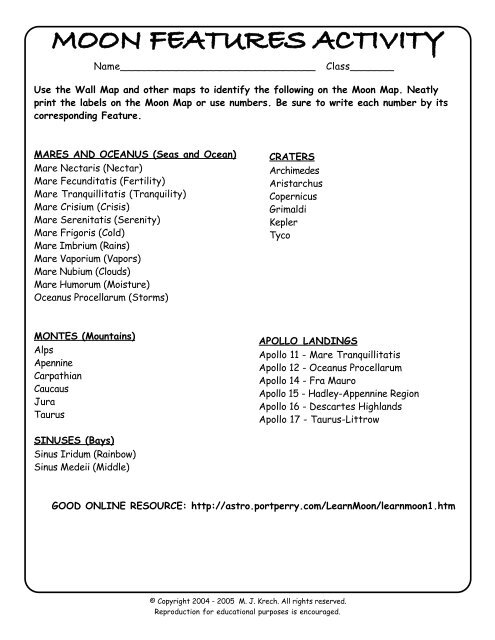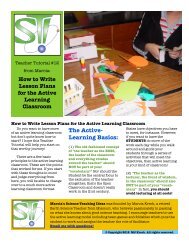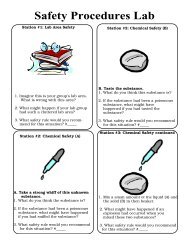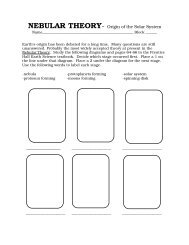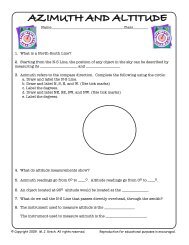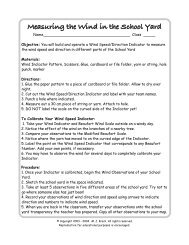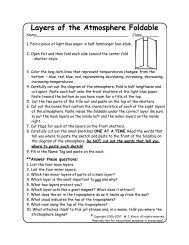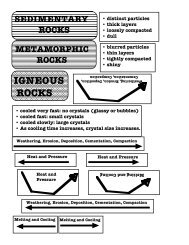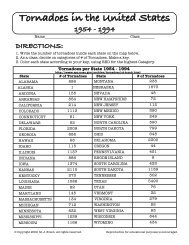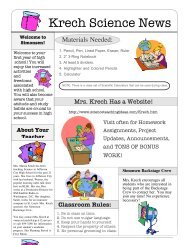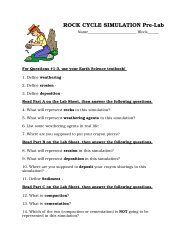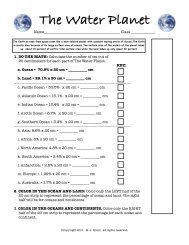MOON FEATURES ACTIVITY
MOON FEATURES ACTIVITY
MOON FEATURES ACTIVITY
You also want an ePaper? Increase the reach of your titles
YUMPU automatically turns print PDFs into web optimized ePapers that Google loves.
<strong>MOON</strong> <strong>FEATURES</strong> <strong>ACTIVITY</strong><br />
Name_______________________________<br />
Class_______<br />
Use the Wall Map and other maps to identify the following on the Moon Map. Neatly<br />
print the labels on the Moon Map or use numbers. Be sure to write each number by its<br />
corresponding Feature.<br />
MARES AND OCEANUS (Seas and Ocean)<br />
Mare Nectaris (Nectar)<br />
Mare Fecunditatis (Fertility)<br />
Mare Tranquillitatis (Tranquility)<br />
Mare Crisium (Crisis)<br />
Mare Serenitatis (Serenity)<br />
Mare Frigoris (Cold)<br />
Mare Imbrium (Rains)<br />
Mare Vaporium (Vapors)<br />
Mare Nubium (Clouds)<br />
Mare Humorum (Moisture)<br />
Oceanus Procellarum (Storms)<br />
CRATERS<br />
Archimedes<br />
Aristarchus<br />
Copernicus<br />
Grimaldi<br />
Kepler<br />
Tyco<br />
MONTES (Mountains)<br />
Alps<br />
Apennine<br />
Carpathian<br />
Caucaus<br />
Jura<br />
Taurus<br />
APOLLO LANDINGS<br />
Apollo 11 - Mare Tranquillitatis<br />
Apollo 12 - Oceanus Procellarum<br />
Apollo 14 - Fra Mauro<br />
Apollo 15 - Hadley-Appennine Region<br />
Apollo 16 - Descartes Highlands<br />
Apollo 17 - Taurus-Littrow<br />
SINUSES (Bays)<br />
Sinus Iridum (Rainbow)<br />
Sinus Medeii (Middle)<br />
GOOD ONLINE RESOURCE: http://astro.portperry.com/LearnMoon/learnmoon1.htm<br />
© Copyright 2004 - 2005 M. J. Krech. All rights reserved.<br />
Reproduction for educational purposes is encouraged.
SUMMARY QUESTIONS:<br />
1. How are mares and highlands similar?<br />
different?<br />
2. What two mares are traditionally thought to be the eyes of the "Man in the Moon?"<br />
Do you agree with this? _________<br />
Why or why not?<br />
What other two features of the Moon could be used as the eyes of a person?<br />
3. Which one is older, mare or highlands?<br />
How could we know this without knowing the age of the rocks in both areas?<br />
4. Why do all the Latin names for the features of the Moon relate to water and weather?<br />
5. Why did the Moon Lander have such wide, flat landing "feet" on the ends of long, thin "legs?"<br />
Were they necessary? _____________<br />
How do you know?<br />
6. Armstrong's first footprint is still visible on the surface of the Moon. We know this even<br />
though no one has returned to the moon in over 30 years. How can we know this for sure?<br />
7. "WASHINGTON, Jan. 8, 2004 (UPI) -- American astronauts will return to the moon early in<br />
the next decade in preparation for sending crews to explore Mars and nearby asteroids..."<br />
What benefits might humans on Earth enjoy from such a mission?<br />
8. Moon rocks brought back to Earth by Apollo mission astronauts are mostly made of the mineral,<br />
FELDSPAR, which makes up most rocks on Earth. What might this mean?<br />
© Copyright 2004 - 2005 M. J. Krech. All rights reserved.<br />
Reproduction for educational purposes is encouraged.
© Copyright 2004 - 2005 M. J. Krech. All rights reserved.<br />
Reproduction for educational purposes is encouraged.
<strong>MOON</strong> MAP<br />
NOTE: Neatly print the labels on the Moon Map or use numbers.<br />
Be sure to write each number by its corresponding Feature.<br />
© Copyright 2004 - 2005 M. J. Krech. All rights reserved.<br />
Reproduction for educational purposes is encouraged.


